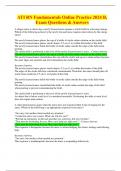Essay
how far did the aims of Civil rights Campaigners remain the same in the years
- Course
- Institution
This is a fantastic resource set out thematically in Political, Social and Economic Paragraphs, that questions the extent to which throughout the period the aims of the campaigners had remained the same. The essay notes the differing aims of earlier leaders such as Booker T Washington, Du Bois...
[Show more]












